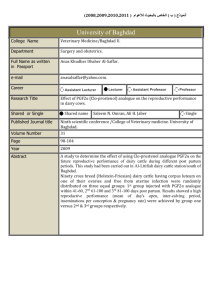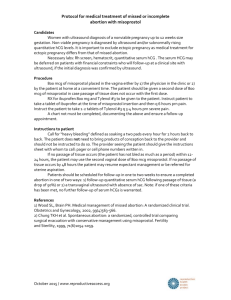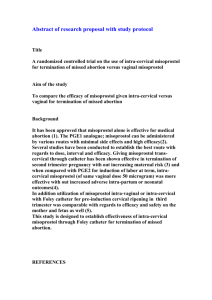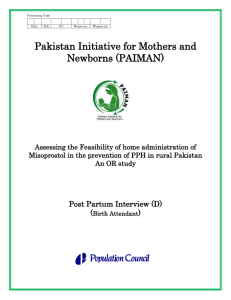400µg MISOPROSTOL VERSUS 125µg PGF2 α
advertisement
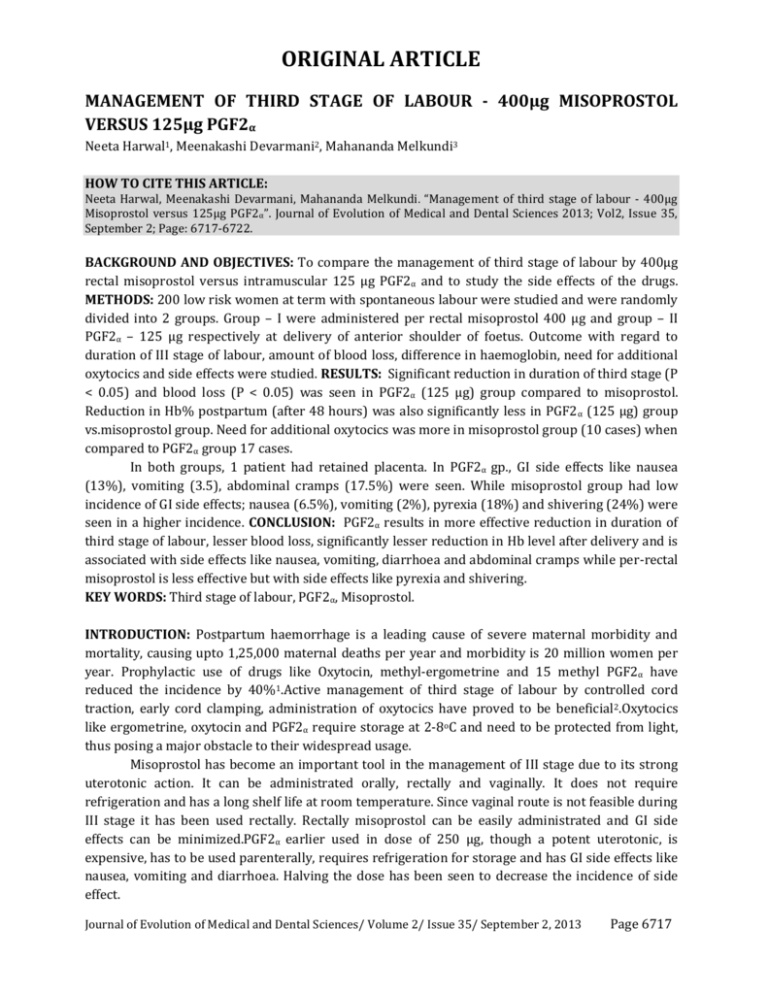
ORIGINAL ARTICLE MANAGEMENT OF THIRD STAGE OF LABOUR - 400µg MISOPROSTOL VERSUS 125µg PGF2α Neeta Harwal1, Meenakashi Devarmani2, Mahananda Melkundi3 HOW TO CITE THIS ARTICLE: Neeta Harwal, Meenakashi Devarmani, Mahananda Melkundi . “Management of third stage of labour - 400µg Misoprostol versus 125µg PGF2α”. Journal of Evolution of Medical and Dental Sciences 2013; Vol2, Issue 35, September 2; Page: 6717-6722. BACKGROUND AND OBJECTIVES: To compare the management of third stage of labour by 400µg rectal misoprostol versus intramuscular 125 µg PGF2α and to study the side effects of the drugs. METHODS: 200 low risk women at term with spontaneous labour were studied and were randomly divided into 2 groups. Group – I were administered per rectal misoprostol 400 µg and group – II PGF2α – 125 µg respectively at delivery of anterior shoulder of foetus. Outcome with regard to duration of III stage of labour, amount of blood loss, difference in haemoglobin, need for additional oxytocics and side effects were studied. RESULTS: Significant reduction in duration of third stage (P < 0.05) and blood loss (P < 0.05) was seen in PGF2α (125 µg) group compared to misoprostol. Reduction in Hb% postpartum (after 48 hours) was also significantly less in PGF2 α (125 µg) group vs.misoprostol group. Need for additional oxytocics was more in misoprostol group (10 cases) when compared to PGF2α group 17 cases. In both groups, 1 patient had retained placenta. In PGF2α gp., GI side effects like nausea (13%), vomiting (3.5), abdominal cramps (17.5%) were seen. While misoprostol group had low incidence of GI side effects; nausea (6.5%), vomiting (2%), pyrexia (18%) and shivering (24%) were seen in a higher incidence. CONCLUSION: PGF2α results in more effective reduction in duration of third stage of labour, lesser blood loss, significantly lesser reduction in Hb level after delivery and is associated with side effects like nausea, vomiting, diarrhoea and abdominal cramps while per-rectal misoprostol is less effective but with side effects like pyrexia and shivering. KEY WORDS: Third stage of labour, PGF2α, Misoprostol. INTRODUCTION: Postpartum haemorrhage is a leading cause of severe maternal morbidity and mortality, causing upto 1,25,000 maternal deaths per year and morbidity is 20 million women per year. Prophylactic use of drugs like Oxytocin, methyl-ergometrine and 15 methyl PGF2α have reduced the incidence by 40%1.Active management of third stage of labour by controlled cord traction, early cord clamping, administration of oxytocics have proved to be beneficial2.Oxytocics like ergometrine, oxytocin and PGF2α require storage at 2-8oC and need to be protected from light, thus posing a major obstacle to their widespread usage. Misoprostol has become an important tool in the management of III stage due to its strong uterotonic action. It can be administrated orally, rectally and vaginally. It does not require refrigeration and has a long shelf life at room temperature. Since vaginal route is not feasible during III stage it has been used rectally. Rectally misoprostol can be easily administrated and GI side effects can be minimized.PGF2α earlier used in dose of 250 µg, though a potent uterotonic, is expensive, has to be used parenterally, requires refrigeration for storage and has GI side effects like nausea, vomiting and diarrhoea. Halving the dose has been seen to decrease the incidence of side effect. Journal of Evolution of Medical and Dental Sciences/ Volume 2/ Issue 35/ September 2, 2013 Page 6717 ORIGINAL ARTICLE This study has been undertaken to evaluate the efficacy of 400µg Rectal Misoprostol and 125 µg of I5 Methyl PGF2α in the management of third stage of labour and also compare drugs for prevention of postpartum haemorrhage in third stage of labour. MATERIAL AND METHODS: A prospective randomized study was conducted in the department of OBG M.R. Medical College, Gulbarga to compare the efficacy of intramuscular PGF2α and rectal misoprostol in the management of third stage of labour. 200 pregnant women with term spontaneous onset of labour were randomly divided into 2 groups of 100 women each in group I and II. Group I was administered 400 µg of Rectal Misoprostol and groupII was administered 125 µg of PGF2α intramuscularly. Each of the patients was allotted to one of the groups by coloured gains method (self-selection–random sampling method). All women in the age group of 19–30 years with 37–40 weeks of gestation and gravida – 1 to 4, with spontaneous onset of labour were included in the study. Women with multiple pregnancy, intrauterine foetal death, previous caesarean section, gestational hypertension, antepartum haemorrhage, heart diseases, bronchial asthma, renal diseases, liver disease and history of allergy to these drugs were excluded from the study. An informed consent was taken from the patients who met the inclusion criteria. The women were subjected to a thorough general and systemic examination. Blood loss during the third stage of labour and in the first hour after delivery was calculated by keeping a sterile kidney tray at the vulva after delivery of foetus and the volume of blood was measured using a measuring jar. Oxytocin augmentation was stopped after delivery and need for intravenous fluids or blood was noted. Duration of third stage of labour, side effects were noted. If bleeding exceeded the normal limits, additional oxytocics were administered and this was also noted. Haemoglobin estimated in gms% was performed at admission and repeated 48 hours postpartum. Statistical analysis of the 2 groups was done by chi-square test and t-test (normality test). Categorical data was analysed by chisquare test and comparative study by the ‘t’ test. A two tailed p<0.05 was considered statistically significant. RESULTS: Patients were distributed as group I with 100 patients in whom tablet Misoprostol 400µg was given per-rectally after delivery of anterior shoulder and group II of 100 women who received 125µg of 15 – methyl PGF2αi.m. after delivery of anterior shoulder. 93 (46.5%) patients were in age group 23 – 26 years; 64 (32%) in age group of 19 – 22 years and 43 (21.5%) were in age group 27 – 30 years. Mean age of patients was 24.3 years with standard duration of 2.9 years. Maximum patients delivered at 39 – 40 weeks in both groups with mean being 38.3 ± 1.2 weeks.Misoprostol group consisted of 51% multigravidae and 49% primigravidae and in PGF2α group 37% were multigravidae and 63% were primigravidae. Table – 1: Amount of blood loss in third stage of labour Blood loss (ml) Misoprostol PGF2α 50 – 100 09 38 101 – 200 37 51 201 – 300 35 03 301 – 400 10 01 Journal of Evolution of Medical and Dental Sciences/ Volume 2/ Issue 35/ September 2, 2013 Page 6718 ORIGINAL ARTICLE 401 – 500 501 – 650 Total Mean ISD Unpaired t test 02 07 100 236.8 ± 119.9 t = 4.36 01 01 100 160 ± 127.5 P < 0.05 significant Table – 1 shows amount of blood loss in third stage was observed in both groups. Average blood loss in misoprostol group was 236.9 ± 119.9 ml and in PGF2α group it was 160 ± 127.5 ml. So there is a significant decrease in blood loss in PGF2α group compared to misoprostol group with P value < 0.05 which is significant. Additional oxytocics in the form of 10 IU oxytocin in intravenous drip was required in 10 and 7 patients in group I and II respectively. In both groups 1 patient had retained placenta. Blood transfusion was required in 8 and 7 patients in group I and II respectively, chi-squire value was 0.072 with P value > 0.05 – Nil significant. Misoprostol group was found to have average fall in Hb level of 0.69 gm/dl whereas it was 0.49 gm/dl in PGF2α group unpaired t – test with P value of < 0.05, fall in Hb was less in PGF2α group when compared to misoprostol group suggesting statistically significant association. Table – 2: Average blood loss in ml Parity Misoprostol PGF2α G1P0 250.3 162.7 G2P1 228.6 154.3 G3P2 210.3 171.1 G4P3 266.7 200 P value P > 0.05 NS P > 0.05 NS Table – 2 shows Parity of the patient did not alter the amount of blood loss as evidenced by P value of > 0.05 which is considered not significant. Groups Misoprostol PGF2α Table –3: Average duration of third stage of labour III stage labour mean SD Significant duration (mins) 8.03 3.23 T = 7.37 5.26 1.9 P < 0.05 (significant) Table – 3 shows average duration of third stage of labour to be shorter in PGF2αgp. 5.26 ± 1.9 mins as compared to 8.03 ± 3.23 mins in misoprostol group, T value was 7.37 with p value of < 0.05. Duration of third stage of labour was significantly reduced in PGF2α group. Journal of Evolution of Medical and Dental Sciences/ Volume 2/ Issue 35/ September 2, 2013 Page 6719 ORIGINAL ARTICLE Table – 4: Side effects of drugs Side effects Misoprostol Nausea 13 (6.5%) Vomiting 4 (2%) Shivering 48 (24%) Pyrexia 36 (18%) Diarrhoea 0 Abdominal cramps 26 (13%) PGF2α 26 (13%) 7 (3.5%) 0 0 12 (6%) 35 (17.5%) Table – 4 shows the incidence of side effect was higher in the misoprostol group than in PGF2α group. DISCUSSION: The third stage of labour is indeed the unforgiving of all the stages of labour and in it lurks more unheralded treachery than in both the other stages of labour combined. A normal case within a minute can become abnormal and successful delivery can swiftly turn into a disaster if neglected3.The third stage usually lasts between 5 and 15 minutes but any period up to 1 hour may be considered to be within normal limits4. However increasing incidence of complications were seen when the duration of third stage exceeded 30 minutes5.Drugs conventionally used for PPH prophylaxis including Oxytocin, methyl-ergometrine and 15 methyl PGF2α used after delivery of the infant has shown to reduce the incidence by 40%1. Ramsey and Ramin etal6 stated that sustained uterine contractions observed within 3 minutes after drug administration were secondary to rectal misoprostol. Goldberg et al7 state that there is insufficient evidence to support the routine use of misoprostol to prevent PPH, when oxytocin or methyl ergometrine is available, but misoprostol may lower the incidence of PPH if these drugs are not available. A Cochrane systematic8 review identified 5 randomized controlled trails comparing active and expectant management. Active management was found to be associated with shorter third stage duration (mean difference – 9.77 minutes) a reduced risk of PPH, reduced risk of anaemia, a decreased need for blood transfusion and a decreased need for additional uterotonic medications. Active management was also associated with an increased risk of maternal nausea, vomiting and elevated blood pressure caused by the uterotonic medication in 4 of the 5 studies in the systematic review. Bhide et al9 conducted a comparative study of 3 commonly available oxytocics – methyl ergometrine (0.2mg), oxytocin (10 units) and PGF2α (125 µg) with 30 patients each in regard to blood loss and duration of third stage of labour, which was 6 minutes 30 seconds, 5 minutes and 3 minutes 15 seconds respectively. In their observation, blood loss with PGF2 α was relatively less. Patki et al10 came to the conclusion that PGF2α is a better alternative in prevention of PPH when compared to methyl ergometrine. In their study, they concluded that intramuscular PGF2α helps in active management of third stage to reduce postpartum blood loss and could shorten the third stage duration without promoting a cascade of intervention. Kamalajayram et al11 studied 100 patients of atonic PPH using IV methyl egometrine (0.2 mg) and IM PGF2α at birth of anterior shoulder. They concluded that PGF2α is superior to methyl ergometrine esp. in high risk patients and that benefits of using PGF2α outweighed the cost of the drug. Bamyboye et al12 compared rectal misoprostol (400 µg) with syntometerine (0.5 mg + 5 units) in management of third stage of labour in low risk women and found duration of labour, postpartum Journal of Evolution of Medical and Dental Sciences/ Volume 2/ Issue 35/ September 2, 2013 Page 6720 ORIGINAL ARTICLE blood loss and Hb estimation similar in both groups. Vimala et al13 compared sublingual misoprostol 400 µg with 0.2 mg ergometrine and concluded that both are equally effective in prevention of PPH. Misoprostol may be considered for active management of third stage as an alternative uterotonic agent and for preventing PPH in areas where appropriate storage conditions for ergometrine and oxytocin are not available. Misoprostol does not require refrigeration and can be given in hypertensive patients.In the present study, mean duration of labour was found to be shorter in PGF2α group 5.26 ± 1.9 minutes VS 8.03 ± 3.23 minutes in misoprostol group; statistically significant (P < 0.05) decrease in Hb postpartum in PGF2α group: statistically significant reduction in mean blood loss in PGF2α group, lesser patients in PGF2α group(7) required additional oxytocics compared to 10 cases in misoprostol group. However, gastrointestinal side effects like nausea, vomiting and diarrhoea were significantly higher in PGF2α group than in misoprostol group which showed incidence of pyrexia and shivering. Abdominal cramps were equally evident in both groups. CONCLUSION: This comparative study between intramuscular PGF2α (125 µg) and per rectal misoprostol (400 µg) in third stage of labour done in department of OBG, M.R. Medical College, Gulbarga showed lower blood loss, effective reduction in duration of third stage of labour, significantly lesser reduction in Hb level postpartum in PGF2α, but it was associated with unpleasant GI side effects. Per rectal misoprostol, though inexpensive, easy storage requirement, lesser GI side effects was less effective in preventing blood loss, higher fall of Hb with greater number of patients requiring blood transfusion. Hence a cafeteria approach is required in usage of these drugs in reducing postpartum haemorrhage and thus reducing maternal morbidity and mortality. REFERENCES: 1. Tammy S. Gerstenfeld DO, Deborah A, Wing MD; Rectal Misoprostol versus IV oxytocin for prevention of PPH after vaginal delivery. Am J obstetricGynecol, 2001: 185: 78-82. 2. WHO 2001: Global estimates of maternal mortality for 1995: Results of an in-depth review analysis and estimation strategy. Geneva, WHO 2001. 3. Douald I: PPH practical obstetric problems, 5th Ed.; New Delhi, BI publications, 1998, P. 748 – 794. 4. Fraser DM, Cooper MA: Physiology and management of III stage of labour. Myle’s Text Book for midwives. 14th Ed. China, Churchill Livingstone. 5. Leveon KJ, Bloom SL, Hauth JC, Cunningham PG, William’s Obstetrics 22nd Ed., Philadelphia, WB Sunder’s Co. P. 826 – 865. 6. Ramsey PS, Ramin KD: Rectal misoprostol in the prevention of postpartum haemorrhage (Am J. ObstetGynecol, 1999; 180: 1601 – 2. 7. Goldberg AB, Greenberg MB, Darney PD: Misoprostol and pregnancy. The New England Journal of Medicine 2001: 344; 38 – 47. 8. Prendville WJ: Active versus expectant management in III stage of labour (Cochrane Review, March 9, 2001 In; Cochrane Library Issue 4, 2001, Oxford update software Ltd. Journal of Evolution of Medical and Dental Sciences/ Volume 2/ Issue 35/ September 2, 2013 Page 6721 ORIGINAL ARTICLE 9. Bhide P, Bhide A, Daftary S: Modern management of III stage of labour. J. ObsteGynecol, Ind. 1994; 44: 534 – 47. 10. Patki A – Active management of III stage of labour with PGF2α. J. Obstet. Gynecol. Ind. 1993; 43: 734 – 37. 11. Kamalajayaram V, Devi ED, Prophylactic PGF2α for control of PPH, a comparative study with methyl ergometline. J. Obstet. Gynecol. Ind. 1994; 44: 393 – 97. 12. Bamigboye AA, Hofmeya J, Merrell DA. Randomized comparison of rectal misoprostol with systometrine for management of III stage of labour. Acta Obstet. Gynecol. Scand 1998; 77 (2): 178 – 81. 13. Vimal N, Mittal S, Kumar S, Dadhwal V, Mehta S. Sublingnal misoprostol versus intravenous methyl ergometline for active management of III stage of labour. Int. J GynaceolObstet 2004; 7 (1): 1 – 5. 3. AUTHORS: 1. Neeta Harwal 2. Meenakashi Devarmani 3. Mahananda Melkundi PARTICULARS OF CONTRIBUTORS: 1. Professor, Department of Obstetrics and Gynaecology, Mahadevappa Rampure Medical College, Gulbarga. 2. Professor, Department of Obstetrics and Gynaecology, Mahadevappa Rampure Medical College, Gulbarga. Associate Professor, Department of Obstetrics and Gynaecology, Mahadevappa Rampure Medical College, Gulbarga. NAME ADRRESS EMAIL ID OF THE CORRESPONDING AUTHOR: Dr. Neeta Harwal, Dr. Nagathan’s Hospital, Khuba Plots, Gulbarga - 585102. Email – neeta.harwal@gmail.com Date of Submission: 20/08/2013. Date of Peer Review: 21/08/2013. Date of Acceptance: 24/08/2013. Date of Publishing: 28/08/2013 Journal of Evolution of Medical and Dental Sciences/ Volume 2/ Issue 35/ September 2, 2013 Page 6722
